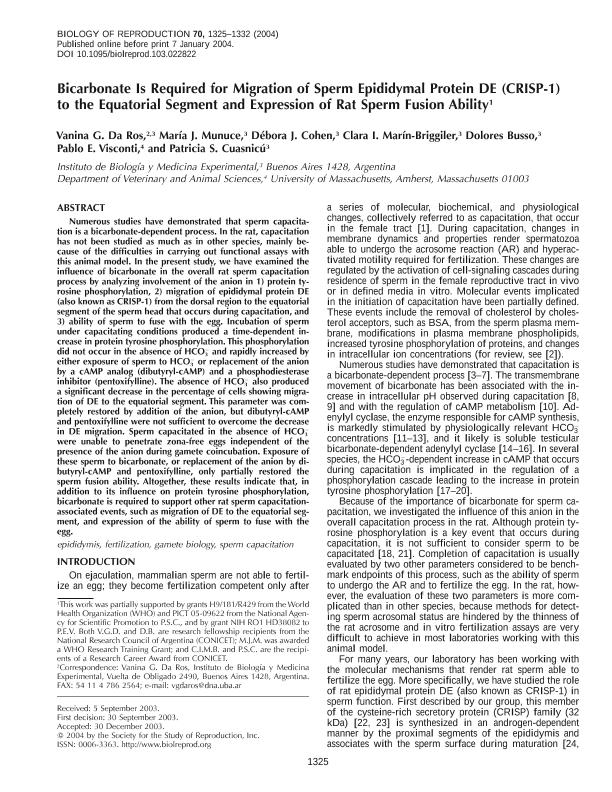Mostrar el registro sencillo del ítem
dc.contributor.author
Da Ros, Vanina Gabriela

dc.contributor.author
Munuce, María José

dc.contributor.author
Cohen, Debora Juana

dc.contributor.author
Marin Briggiler, Clara Isabel

dc.contributor.author
Busso, Dolores
dc.contributor.author
Visconti, Pablo E.
dc.contributor.author
Cuasnicu, Patricia Sara

dc.date.available
2017-11-26T18:13:41Z
dc.date.issued
2004-05
dc.identifier.citation
Da Ros, Vanina Gabriela; Munuce, María José; Cohen, Debora Juana; Marin Briggiler, Clara Isabel; Busso, Dolores; et al.; Bicarbonate is required for migration of sperm epididymal protein DE/CRISP-1 to the equatorial segment and expression of rat sperm fusion ability; Society for the Study of Reproduction; Biology of Reproduction; 70; 5; 5-2004; 1325-1332
dc.identifier.issn
0006-3363
dc.identifier.uri
http://hdl.handle.net/11336/29128
dc.description.abstract
Numerous studies have demonstrated that sperm capacitation is a bicarbonate-dependent process. In the rat, capacitation has not been studied as much as in other species, mainly because of the difficulties in carrying out functional assays with this animal model. In the present study, we have examined the influence of bicarbonate in the overall rat sperm capacitation process by analyzing involvement of the anion in 1) protein tyrosine phosphorylation, 2) migration of epididymal protein DE (also known as CRISP-1) from the dorsal region to the equatorial segment of the sperm head that occurs during capacitation, and 3) ability of sperm to fuse with the egg. Incubation of sperm under capacitating conditions produced a time-dependent increase in protein tyrosine phosphorylation. This phosphorylation did not occur in the absence of HCO3- and rapidly increased by either exposure of sperm to HCO3- or replacement of the anion by a cAMP analog (dibutyryl-cAMP) and a phosphodiesterase inhibitor (pentoxifylline). The absence of HCO3- also produced a significant decrease in the percentage of cells showing migration of DE to the equatorial segment. This parameter was completely restored by addition of the anion, but dibutyryl-cAMP and pentoxifylline were not sufficient to overcome the decrease in DE migration. Sperm capacitated in the absence of HCO3- were unable to penetrate zona-free eggs independent of the presence of the anion during gamete coincubation. Exposure of these sperm to bicarbonate, or replacement of the anion by dibutyryl-cAMP and pentoxifylline, only partially restored the sperm fusion ability. Altogether, these results indicate that, in addition to its influence on protein tyrosine phosphorylation, bicarbonate is required to support other rat sperm capacitation- associated events, such as migration of DE to the equatorial segment, and expression of the ability of sperm to fuse with the egg.
dc.format
application/pdf
dc.language.iso
eng
dc.publisher
Society for the Study of Reproduction

dc.rights
info:eu-repo/semantics/openAccess
dc.rights.uri
https://creativecommons.org/licenses/by-nc-sa/2.5/ar/
dc.subject
Epididymis
dc.subject
Fertilization
dc.subject
Gamete Biology
dc.subject
Sperm Capacitation
dc.subject.classification
Biología Reproductiva

dc.subject.classification
Ciencias Biológicas

dc.subject.classification
CIENCIAS NATURALES Y EXACTAS

dc.title
Bicarbonate is required for migration of sperm epididymal protein DE/CRISP-1 to the equatorial segment and expression of rat sperm fusion ability
dc.type
info:eu-repo/semantics/article
dc.type
info:ar-repo/semantics/artículo
dc.type
info:eu-repo/semantics/publishedVersion
dc.date.updated
2017-11-16T15:13:59Z
dc.identifier.eissn
1529-7268
dc.journal.volume
70
dc.journal.number
5
dc.journal.pagination
1325-1332
dc.journal.pais
Estados Unidos

dc.journal.ciudad
Oxford
dc.description.fil
Fil: Da Ros, Vanina Gabriela. Consejo Nacional de Investigaciones Científicas y Técnicas. Instituto de Biología y Medicina Experimental. Fundación de Instituto de Biología y Medicina Experimental. Instituto de Biología y Medicina Experimental; Argentina
dc.description.fil
Fil: Munuce, María José. Consejo Nacional de Investigaciones Científicas y Técnicas. Instituto de Biología y Medicina Experimental. Fundación de Instituto de Biología y Medicina Experimental. Instituto de Biología y Medicina Experimental; Argentina
dc.description.fil
Fil: Cohen, Debora Juana. Consejo Nacional de Investigaciones Científicas y Técnicas. Instituto de Biología y Medicina Experimental. Fundación de Instituto de Biología y Medicina Experimental. Instituto de Biología y Medicina Experimental; Argentina
dc.description.fil
Fil: Marin Briggiler, Clara Isabel. Consejo Nacional de Investigaciones Científicas y Técnicas. Instituto de Biología y Medicina Experimental. Fundación de Instituto de Biología y Medicina Experimental. Instituto de Biología y Medicina Experimental; Argentina
dc.description.fil
Fil: Busso, Dolores. Consejo Nacional de Investigaciones Científicas y Técnicas. Instituto de Biología y Medicina Experimental. Fundación de Instituto de Biología y Medicina Experimental. Instituto de Biología y Medicina Experimental; Argentina
dc.description.fil
Fil: Visconti, Pablo E.. University of Massachussets; Estados Unidos
dc.description.fil
Fil: Cuasnicu, Patricia Sara. Consejo Nacional de Investigaciones Científicas y Técnicas. Instituto de Biología y Medicina Experimental. Fundación de Instituto de Biología y Medicina Experimental. Instituto de Biología y Medicina Experimental; Argentina
dc.journal.title
Biology of Reproduction

dc.relation.alternativeid
info:eu-repo/semantics/altIdentifier/url/https://academic.oup.com/biolreprod/article/70/5/1325/2712645
dc.relation.alternativeid
info:eu-repo/semantics/altIdentifier/doi/http://dx.doi.org/10.1095/biolreprod.103.022822
dc.relation.alternativeid
info:eu-repo/semantics/altIdentifier/pmid/14711787
Archivos asociados
